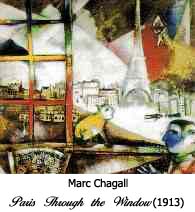 1
Pronounced As: srlizm
, literary and art movement influenced by Freudianism
and dedicated to the expression of imagination as revealed
in dreams, free of the conscious control of
reason and free of convention. The movement
was founded (1924) in Paris by Andr 1
Pronounced As: srlizm
, literary and art movement influenced by Freudianism
and dedicated to the expression of imagination as revealed
in dreams, free of the conscious control of
reason and free of convention. The movement
was founded (1924) in Paris by Andr Breton,
with his Manifeste du surr Breton,
with his Manifeste du surr alisme,
but its ancestry is traced to the French poets
Baudelaire, Rimbaud, Apollinaire, and to the Italian painter, Giorgio de
Chirico.
Many of its adherents had belonged to the
Dada
movement. alisme,
but its ancestry is traced to the French poets
Baudelaire, Rimbaud, Apollinaire, and to the Italian painter, Giorgio de
Chirico.
Many of its adherents had belonged to the
Dada
movement.
2 In literature,
surrealism was confined almost exclusively
to France. Surrealist writers were interested in the associations and implications
of words rather than their literal meanings;
their works are thus extraordinarily difficult to read. Among the leading
surrealist writers were Louis Aragon, Paul Eluard, Robert Desnos,
and Jean Cocteau,
the last noted particularly for his surreal films.
3 In art the movement
became dominant in the 1920s and 30s and was
internationally practiced with many and varied
forms of expression. Salvador Dali
and Yves Tanguy
used dreamlike perception of space and dream-inspired
symbols such as melting watches and huge metronomes.
Max Ernst
and Ren Magritte
constructed fantastic imagery from startling
combinations of incongruous elements of reality
painted with photographic attention to detail. These artists have been
labeled as verists because their paintings
involve transformations of the real world. "Absolute surrealism depends
upon images derived from psychic automatism,
the subconscious, or spontaneous thought.
Works by Joan Mir Magritte
constructed fantastic imagery from startling
combinations of incongruous elements of reality
painted with photographic attention to detail. These artists have been
labeled as verists because their paintings
involve transformations of the real world. "Absolute surrealism depends
upon images derived from psychic automatism,
the subconscious, or spontaneous thought.
Works by Joan Mir and Andr
and Andr Masson
are in this vein. The movement survived but
was greatly diminished after World War II. Masson
are in this vein. The movement survived but
was greatly diminished after World War II.
Giorgio
de Chirico
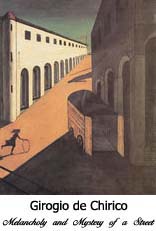 4
Pronounced As: jorjo
da krko , 1888-1978,
Italianpainter, b. V 4
Pronounced As: jorjo
da krko , 1888-1978,
Italianpainter, b. V los, Greece. Chirico
developed his enigmatic vision
in Munich and Italy and from 1911 to 1915 he worked and exhibited in Paris.
His powerful, disturbing paintings employ
steep perspective, mannequin figures, empty
space, and forms used out of context to create an atmosphere of mystery
and loneliness. His work exercised a considerable influence on early surrealist
painters but was never successfully imitated. In Ferrara, Chirico developed
what he termed metaphysical painting, in which
he consciously exploited the symbolism of
his art. Chirico is represented in leading galleries throughout the world. los, Greece. Chirico
developed his enigmatic vision
in Munich and Italy and from 1911 to 1915 he worked and exhibited in Paris.
His powerful, disturbing paintings employ
steep perspective, mannequin figures, empty
space, and forms used out of context to create an atmosphere of mystery
and loneliness. His work exercised a considerable influence on early surrealist
painters but was never successfully imitated. In Ferrara, Chirico developed
what he termed metaphysical painting, in which
he consciously exploited the symbolism of
his art. Chirico is represented in leading galleries throughout the world.
Salvador
Dali
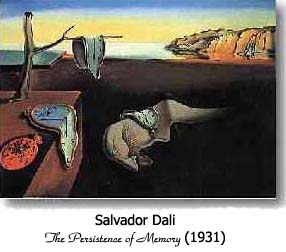 5
Pronounced As:s 5
Pronounced As:s v v thor
d thor
d l l ,
1904-89, Spanish surrealist painter. At first influenced by futurism,
in 1924 Dali came under the influence of Italian Chirico. By 1929 he had
become a leader of surrealism. His precise style enhanced
the nightmare effect of his paintings. Among his best-known works is Persistence
of Memory (1931; Mus. of Modern Art, New York City). In 1940 Dali emigrated
to the United States. He wrote The Secret Life of Salvador Dali
(1942). Dali also made surrealist ventures
in films (e.g., Luis Bu ,
1904-89, Spanish surrealist painter. At first influenced by futurism,
in 1924 Dali came under the influence of Italian Chirico. By 1929 he had
become a leader of surrealism. His precise style enhanced
the nightmare effect of his paintings. Among his best-known works is Persistence
of Memory (1931; Mus. of Modern Art, New York City). In 1940 Dali emigrated
to the United States. He wrote The Secret Life of Salvador Dali
(1942). Dali also made surrealist ventures
in films (e.g., Luis Bu el's Un Chien
andalou, 1928), advertising, and the ballet.
The Salvador Dali Museum, St. Petersburg, Fla., is devoted entirely to
his works. el's Un Chien
andalou, 1928), advertising, and the ballet.
The Salvador Dali Museum, St. Petersburg, Fla., is devoted entirely to
his works.
Yves
Tanguy
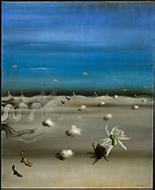 6
Pronounced As:
v
t 6
Pronounced As:
v
t Ng
, 1900-1955, French surrealist painter. At first a merchant
seaman, he saw a picture by Chirico in 1923 and instantly decided to take
up painting. He created vast
imaginary dream landscapes, in which float strange, often amorphous,
objects and personages-allmeticulously
painted. His spontaneous, subconscious imagery remained curiously static
throughout his career. Tanguy moved to the United States in 1939. A number
of his paintings are in the Museum of Modern Art, New York City. Ng
, 1900-1955, French surrealist painter. At first a merchant
seaman, he saw a picture by Chirico in 1923 and instantly decided to take
up painting. He created vast
imaginary dream landscapes, in which float strange, often amorphous,
objects and personages-allmeticulously
painted. His spontaneous, subconscious imagery remained curiously static
throughout his career. Tanguy moved to the United States in 1939. A number
of his paintings are in the Museum of Modern Art, New York City.
Max
Ernst
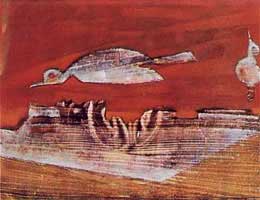 7
Pronounced As:
m 7
Pronounced As:
m ks
ernst 1891-1976,
German painter. After World War I, Ernst joined the Dada movement in Paris
and then became a founder
of surrealism. Apart from the medium of collage,
Ernst developed other devices to express his fantastic vision. In frottage,
he rubbed black chalk on paper held against various materials such as leaves,
wood, and fabrics
to achieve bizarre
effects. A note of whimsy
often characterizes his dreamlike landscapes. Other works reveal an allegorical
imagination. Two Children Are Threatened by a Nightingale and several
other works are in the Museum of Modern Art in New York City. ks
ernst 1891-1976,
German painter. After World War I, Ernst joined the Dada movement in Paris
and then became a founder
of surrealism. Apart from the medium of collage,
Ernst developed other devices to express his fantastic vision. In frottage,
he rubbed black chalk on paper held against various materials such as leaves,
wood, and fabrics
to achieve bizarre
effects. A note of whimsy
often characterizes his dreamlike landscapes. Other works reveal an allegorical
imagination. Two Children Are Threatened by a Nightingale and several
other works are in the Museum of Modern Art in New York City.
Ren Magritte
Magritte
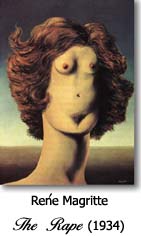 8
Pronounced As:
m 8
Pronounced As:
m grit
,
1898-1967, Belgian surrealist painter. Strongly influenced by Chirico,
Magritte developed a style in which a misleading sort of realism is combined
with mocking irony.
His paintings are dominated by an intensequietude
and restraint,
despite a startling juxtaposition
of images. Characteristic works, such as The Red Model (1935; Modern
Mus., Stockholm), contain elaborate
fantasies constructed around commonplace situations. grit
,
1898-1967, Belgian surrealist painter. Strongly influenced by Chirico,
Magritte developed a style in which a misleading sort of realism is combined
with mocking irony.
His paintings are dominated by an intensequietude
and restraint,
despite a startling juxtaposition
of images. Characteristic works, such as The Red Model (1935; Modern
Mus., Stockholm), contain elaborate
fantasies constructed around commonplace situations.
Joan
Mir
 9
Mir 9
Mir joined a commercial firm as a clerk
in his hometown of Barcelona in 1910. In 1912, he began to paint, and formed
a friendship with Artigas, who later founded the Agrupacio Courbet. In
1918, he held his first exhibition at Dalmau's Gallery in Barcelona, and
in 1921, he held another at the Galerie La Licorne in Paris. Head of Catalan
(1924) and Ploughed Land (1924) signified a change in his artistic style.
He became a successful promoter of surrealist
painting, but was looked down upon by the surrealist group when, in 1926,
he collaborated with Max Ernst on designs
for Diaghilev's Ballets Russes' Romeo and Juliet. From 1940 to 1941,
he painted Constellations, a series of identical-sized
paintings which he finished in Catalonia. The years between 1954 and 1959
were spent mostly on ceramics and lithographs,
and Miro lived most of this time at Palma de Mallorca in a house that Jose
Luis Sert built.
joined a commercial firm as a clerk
in his hometown of Barcelona in 1910. In 1912, he began to paint, and formed
a friendship with Artigas, who later founded the Agrupacio Courbet. In
1918, he held his first exhibition at Dalmau's Gallery in Barcelona, and
in 1921, he held another at the Galerie La Licorne in Paris. Head of Catalan
(1924) and Ploughed Land (1924) signified a change in his artistic style.
He became a successful promoter of surrealist
painting, but was looked down upon by the surrealist group when, in 1926,
he collaborated with Max Ernst on designs
for Diaghilev's Ballets Russes' Romeo and Juliet. From 1940 to 1941,
he painted Constellations, a series of identical-sized
paintings which he finished in Catalonia. The years between 1954 and 1959
were spent mostly on ceramics and lithographs,
and Miro lived most of this time at Palma de Mallorca in a house that Jose
Luis Sert built.
Andr Masson
Masson
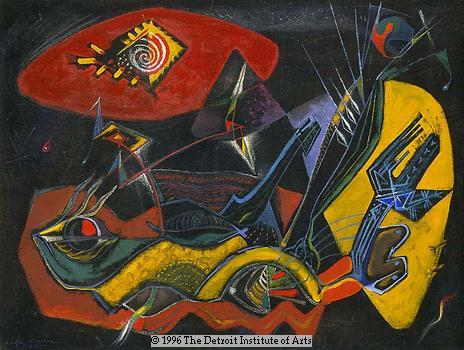 10
Pronounced As: 10
Pronounced As:  Ndra
m Ndra
m s s N
, 1896-1987, French painter and graphic artist. An exponent
of surrealism until 1928, Masson developed "automatic writing-spontaneous
linear
expressions of his personal mythology. After World War II he painted superb
landscapes in Aix-en-Provence. His Meditation on an Oak Leaf and
other works are in the Museum of Modern Art, New York City. N
, 1896-1987, French painter and graphic artist. An exponent
of surrealism until 1928, Masson developed "automatic writing-spontaneous
linear
expressions of his personal mythology. After World War II he painted superb
landscapes in Aix-en-Provence. His Meditation on an Oak Leaf and
other works are in the Museum of Modern Art, New York City. |
